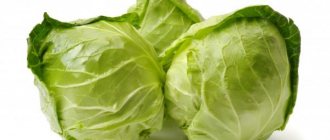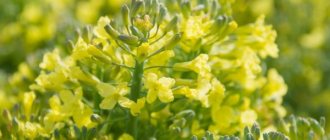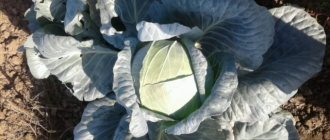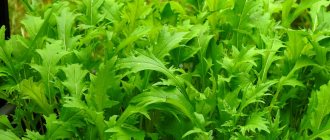The Podarok cabbage variety became widespread in our country back in 1961, but has not yet lost its popularity. The point is the excellent commercial and taste qualities of the variety, its resistance to different climatic conditions and diseases. You will learn about what other benefits Podarok cabbage has and how to grow it correctly in this article.
Cabbage Gift
Podarok cabbage can be grown in all regions of the country
Cabbage has a pleasant sweetish taste
Characteristics, productivity
There are several main parameters characteristic of the variety:
- Form. Round, slightly flattened on top.
- Color. Externally grayish-green, slightly yellowish inside.
- Leaves. Oval or round in shape, wavy at the edges. The upper leaves are covered with a faint waxy coating.
- Head of cabbage. It has a fairly dense structure. Medium size.
- Maturing period. Medium late. Harvesting occurs 4-4.5 months after planting.
Table of the main characteristics of cabbage variety Podarok:
| Growing season, days | Socket diameter, m | Weight, kg | Poker size, cm | Productivity, kg/sq. m |
| 120-135 | up to 1 | 3-5 | 20-25 | 9 |
Application
Cabbage contains many vitamins and nutrients, so it can be used in the manufacture of baby food and dietary products. Also, the fruits of the plant help improve well-being in case of ulcers and diseases of the cardiovascular system.
The fruits have a pleasant, slightly sweet taste, so they are suitable for consumption fresh or cooked. They do not lose their qualities when salted and fermented, so they can be used for winter preparations.
Read about other varieties of cabbage for pickling and pickling in the next article.
The commercial qualities of the variety make it suitable for sale.
Advantages and disadvantages
The main advantages of growing the Podarok variety:
- Sustainability. The fruits practically do not crack and tolerate temperature changes well.
- Duration of storage. Cabbage does not lose its external and taste qualities.
- Productivity. Even under unfavorable conditions you can get a good harvest.
- Possibility of transportation. Fruits are not damaged during long-distance transportation.
- Germination. Most seeds germinate when planted.
Among the disadvantages are:
- Growing conditions. It is necessary to create suitable conditions for growing the variety. You need to take care of optimal soil moisture and the presence of nutrients in it.
- Susceptibility to pests. Cabbage is often damaged by common pests.
Characteristics, advantages and disadvantages
“Podarok” compares favorably with other varieties due to its keeping quality. It keeps well for up to 7 months. It has excellent taste properties. Can be grown in any region. The variety is universal, high-yielding. Suitable for both fresh salads and pickling.
The advantages of “Gift” cabbage include:
- frost resistance;
- unpretentiousness;
- excellent taste;
- good transportability;
- resistance of heads of cabbage to cracking;
- high productivity.
Disadvantages include increased moisture-loving and demanding soil fertility.
Agricultural technology
To get a good harvest of Podarok cabbage, you need to pay attention to the main features and growing conditions.
Selection and preparation of beds
Before planting, the breast is prepared according to the following recommendations:
- Good lighting. Required for cabbage ripening. Therefore, the place where the garden bed will be located should be in the sun, away from trees that can create shadow.
- Soil acidity. Care must be taken that it has low or neutral acidity. This can be achieved by liming the soil.
- Loose soil. The soil must be loosened. This can be done in the fall or right before planting.
- Applying fertilizers in the fall. To do this, add humus or manure and mineral fertilizers to the soil, preferably based on potassium and phosphate. Organic fertilizers require at least 2 buckets per 1 sq. m.
- Fertilizing in spring. In the spring, immediately before planting, the soil should be enriched with nitrogen fertilizers.
Good and bad predecessors
The correct choice of precursor crops is important to stimulate cabbage growth and prevent diseases. For example, if you plant vegetables where cruciferous plants are grown, they become vulnerable to clubroot disease.
But when planting cabbage after legumes and cucumbers, it receives more nutrients and grows better.
How to choose seeds?
Seeds should be purchased only in specialized stores in packaging from the manufacturer. This way there is a lower risk of purchasing a fake. Seeds from the brands “Poisk”, “Aelita”, “Gavrish” are popular.
Before planting, sort through the seeds, get rid of empty and small ones. A great way to select good material is to soak it in a 3% salt solution. If the seeds float, they are not suitable for planting.
Seedling
There are several important points to pay attention to.
Seedling preparation time
Planting seeds for seedlings should be carried out 1-1.5 months before replanting the plants in the ground. The procedure is carried out mainly at the end of April.
Seed preparation
Preparation for planting seeds is as follows:
- Soil preparation. In the container for planting, place a ready-made mixture for seedlings, which can be bought at a specialty store, turf soil and sand in equal proportions. For 1 kg of soil obtained, add 1 tbsp. l. ash. Pour the mixture with a 1% solution of potassium permanganate. After this, it needs to be left for several days so that the soil is saturated with useful substances, and only then can you begin planting.
- Seed preparation. Soak the seeds for 20 minutes in water heated to 48-50 degrees. Then hold under running water for 5 minutes. After this, place it in melt water or a solution with a growth stimulator for 18 hours.
Plant the seeds as soon as they swell.
How to prepare cabbage seeds and sow without further diving is described in the video:
Sowing
Seeds can be planted either in separate containers or with subsequent picking.
1st method:
- plant 2-3 seeds in 1 plastic or peat cup with soil;
- As they grow, thin out the seedlings until only 1 sprout remains.
After picking, the plants should be shaded.
Read the next article on how to properly pick cabbage.
2nd method:
- place the seeds in a container at a distance of 2 cm from each other;
- deepen the seed into the soil no more than 1 cm;
- As soon as the plants have 2 leaves, plant them in separate containers.
The necessary conditions
Seedlings need the following care:
- Lighting. Place the container on a well-lit windowsill. In cloudy weather, you can create artificial lighting using a lamp.
- Temperature. Make sure it is about 18 degrees during seed germination. As soon as the first shoots appear, you need to reduce the temperature by 3 degrees.
- Watering. Produce when dry. Excessive moisture can lead to diseases.
- Feeding. Apply after the plants have 2 leaves.
- Hardening. 1-2 weeks before planting, take the plants outside or onto the balcony so that they get used to the climatic conditions. Increase the hardening time gradually.
Transplanting seedlings into the ground
It is carried out in May, when it is warmer outside. It is best to do this in the evening, in the pre-sunset hours. The ideal option would be the period after rain.
To transplant seedlings you need:
- Prepare the soil. To do this, pour it well with settled water so that dirt forms. If there was heavy rain before this, then this procedure is not required.
- Transplanting. Deepen it into the ground to the level of the bottom sheet. Sprinkle dry soil around it to retain moisture.
- Warming plants. To help plants take root, cover them with non-woven material that allows water and air to pass through for 2 weeks. If desired, it can be left in place until ripe. It will protect plants from pests and ensure that the optimum temperature is maintained.
Cabbage should be planted at a distance of about 40 cm from each other. The distance between rows must be at least 70 cm.
Sowing seeds in open ground
If the soil is loose enough, you can sow the seeds in the furrows. Otherwise, loosen the soil and make small holes, about 1 cm deep.
It is better to plant according to the pattern 70 by 70 or even 80 by 80.
The procedure is recommended to be carried out in mid-May, when the ground is already sufficiently warm. The air temperature outside should not fall below 12 degrees.
In the northern regions, cabbage is planted under plastic bottles or thermal film, which are removed at the first warming.
For information on how to plant cabbage seedlings, watch the following video:
Description of the cabbage variety Gift
This mid-late cabbage variety has excellent taste and commercial qualities , and is also resistant to pests, diseases and temperature changes.
Origin and development
The variety was bred by scientists from the All-Russian Scientific Research Institute for Selection and Seed Production of Vegetable Crops in the Moscow Region . In 1961 it was included in the State Register of Seed Material. Previously, numbers were also used in the name to indicate the variety, but in reality there was no difference between them.
Chemical composition and beneficial properties
The vegetable has the following composition per 100 g:
- 4.7-6.2 g – sugary substances;
- 26-41 mg – ascorbic acid.
The calorie content of this variety of cabbage is only 27 kcal , which makes it an indispensable product in health-improving diets.
Important! Sauerkraut contains 19 kcal per 100 g and is recommended as an essential product in the diet for problems with the gastrointestinal tract. Dietary fiber improves digestion.
Cabbage is rich in vitamins, as well as macro- and microelements (per 100 g):
- C – 45 mg (50%);
- B9 – 22 mcg (6%);
- potassium – 300 mg (12%);
- calcium – 45 mg (5%);
- magnesium – 16 mg (4%);
- cobalt – 3 mcg (30%).
The product is very important for baby food . Cabbage is one of the first vegetables introduced into complementary foods.
Features of application
Cabbage is used in the preparation of hot dishes, salads, baked goods and preparations . Vitamins are preserved even when fermented or pickled, so the heads of cabbage are used for harvesting for the winter.
Ripening period
The gift belongs to the mid-late varieties: 100-115 days pass from germination to ripening . Within a month, the remaining heads of cabbage ripen.
For pickling, it is recommended to leave the cabbage to ripen at a temperature of +5 to –2°C and harvest it at the first frost.
Productivity
Subject to compliance with agricultural technology from 1 sq. m harvest up to 9 kg . Under normal conditions, the average weight of a head of cabbage is 3-4 kg.
Cabbage has a very high percentage of ripening , so approximately 99% of the total volume is ultimately considered marketable.
Disease resistance
The gift is resistant to major diseases, but problems can arise if planted and cared for incorrectly. The most dangerous:
- clubroot - because of it, swellings appear on the roots, the growth of the plant is delayed, the foliage turns yellow, and if infected, the cabbage must be destroyed;
- downy mildew - darkening or plaque appears on the outside of the leaves;
- Fusarium - leaves wither and fall off, so infected plants are disposed of.
Cold resistance
Cabbage is a cold-resistant crop, and this variety is especially so . It can withstand short-term frosts down to –4°C.
Description of appearance and taste
Heads of cabbage are distinguished by a rosette that reaches a diameter of 100 cm. The leaves are smooth, spreading, slightly wrinkled along the edges.
Usually the heads of cabbage are round, but can be flat-rounded. The stalks are of medium length, the forks are dense and juicy. The leaves are gray-green in color, but the head is slightly yellowish when cut.
The taste is sweetish, so the variety is suitable for pickling.
For which regions is it best suited?
Due to its resistance to cold, this variety of cabbage is suitable for growing in any region. In the northern regions of Siberia or the Urals, seeds are planted under plastic bottles or film, and ideally seedlings are used.
Care
The productivity of cabbage gift depends on proper care.
Watering
Cabbage needs good watering. Make sure the soil around the plants is always slightly moist. Apply water under the roots. In hot weather, spray plant leaves with cool water.
Immediately after transplanting the seedlings, you need to add about 2 liters of water per plant. As soon as a head of cabbage begins to form, the rate should be increased to 3-4 liters.
Loosening and weeding
You need to remember the rules:
- Removing weeds. Remove them as they appear. It is better not to wait until weeds begin to scatter seeds.
- Flushing of the ground. Is one of the most important points of care. Make sure that the soil around the plants is always loose. The procedure must be carried out immediately after watering, as soon as the soil is saturated with moisture.
- Hilling. Should not be done too often. Plants need to be earthed up 21 days after transplanting into the garden bed, and then once more after 2 weeks. This will help the development of the root system.
Feeding
Fertilize after watering or rain.
In total, you need to apply fertilizer 2-3 times:
- 2 weeks after planting. Add urea solution.
- 5 weeks after planting. Fertilize the plants with potassium and superphosphate.
- 8 weeks after planting. Same as 2nd. It is carried out in case of severe soil depletion.
Be careful when choosing fertilizer, as it may affect the taste of the fruit.
You can apply fertilizer as needed, paying attention to the following external signs of plants:
- Slow growth. It is necessary to enrich the soil with a nitrogen solution.
- Purple tint of leaves. It's better to add superphosphate.
- White spots on the surface of the leaf. Apply potash fertilizers.
Harvest and storage
Harvest usually occurs around mid-October. The maturity of cabbage is indicated by the density and hardness of the head of cabbage and its large size. It is best to harvest in cool weather, as the vegetables will store better this way. But it is better to collect before frost.
If you plan to pickle the cabbage, you can leave it in a slight frost, so it will become sweeter.
You need to pull out the heads of cabbage along with the roots. Then the stalk is cut at a distance of 4 cm from the head of cabbage. The procedure is not required if you plan to harvest cabbage for seeds.
Next comes sorting. Only dense heads of cabbage can be stored; loose ones are prepared urgently, fermented or pickled.
It is recommended to store in cool cellars or basements, placing the heads of cabbage on wooden shelves. The temperature should be no higher than 5 degrees. Optimal air humidity is 90%.
If all conditions are met, cabbage can retain its quality for up to 6 months.
Procurement of seeds
To guarantee a good harvest of Podarok cabbage, you can prepare the seeds yourself. The procedure is not complicated and can be done at home. To do this, you need to take a head of cabbage from last year's harvest. It should be large and dense; you can only take heads of cabbage that have been pulled out by the roots.
The following actions need to be taken:
- Carefully cut out the stalk, being careful not to damage the apical bud. It is located inside the head of cabbage.
- Plant the stalk in the garden bed, root down. Make sure that there are no plants from the Cruciferous family nearby, otherwise you may end up with a hybrid. Care for the mother cabbage as you would for regular cabbage.
- As soon as the stems begin to appear, tie them to the stake, being careful not to damage them.
- Once the seed pods have yellowed, remove the stalk from the soil. Otherwise, the seeds may fall off.
- Cut the stems and place them on cloth or film in a warm place to dry thoroughly.
- Thresh the pods using a wooden block. A wooden shovel handle will also work.
- To separate the seeds, pass the resulting mixture through a sieve or blow it in the wind.
- Dry the seeds again, put them in a dry and dark place before planting.
The resulting seeds can be stored for 5-10 years.
Planting and propagating cabbage
To get a good harvest, it is important to grow high-quality and strong seedlings.
Seed selection
It is better to purchase seeds from trusted sellers in branded packaging. This way, the risk of purchasing a completely different variety will be minimal. Before sowing, they must be soaked in a weak solution of potassium permanganate. Floating seeds are unsuitable for planting.
Dates and sowing pattern
Seeds are sown in the soil mixture at the end of April. A substrate of 75% peat, 20% turf soil and 5% sand is suitable for this. The soil is poured into containers and watered with an antifungal drug, and only a couple of days later they begin to sow the seeds.
The seeds are planted at a distance of 5 cm from each other, buried 1.5 cm deep. The first shoots will appear in 7 days.
Seedling care
Immediately after sowing, the container is placed on a window with good lighting, the temperature is maintained at least 18ºC. After the seedlings emerge, the temperature is reduced to 15ºC and transferred to a slightly shaded place. In this way, the seedlings are hardened.
In cloudy weather, it is necessary to provide additional lighting in the form of lamps.
Read also: Planting cabbage in open ground, choosing the right location, caring for seedlings - Vegetable garden, Description, tips, reviews, photos and videos
Diseases
Cabbage Podarok has a fairly high immunity to common diseases. But if the planting conditions are not met, it can be affected by clubroot and blackleg.
Preventive measures will help avoid the development of cabbage diseases:
- Correct landing. Care must be taken to select suitable predecessor crops. You should also change the place where you plant cabbage every time. You can plant the plant in the same place only after 3 years.
- Nice neighborhood. If you plant cabbage next to onions and garlic, it will be more protected from diseases.
- Soil cultivation. The soil must be safe and contain useful substances. After watering, you need to fluff the soil with the addition of ash.
- Procurement of seeds. They need to be disinfected before planting.
- Maintaining optimal water regime. The soil should not dry out, but it should not be over-moistened either.
- Preventive treatments. There are special disinfecting solutions that can be purchased in stores. They need to be added to the soil before planting and at the first signs of disease development.
- Sorting. If individual plants are infected, they must be removed and destroyed. Treat the rest of the cabbage with a special product.
History of variety development
This variety was bred by breeders working at the Gribov experimental station at the beginning of the second half of the last century. Podarok cabbage was added to the State Register of the USSR in 1961. This variety was bred specifically for cultivation on an industrial scale, but this cabbage is also successfully grown on private farms.
The variety is recommended for cultivation throughout almost the entire territory of Russia, except for the regions of the Far North and a number of other cold areas.
Pests
There are several types of pests to which cabbage Gift is vulnerable:
- Aphid. The most dangerous pest, since it is almost impossible to save cabbage from it. Preventive measures. Before planting, treat the seeds with garlic solution. To do this, pour 50 ml of hot water into 3 crushed cloves. Immerse the seeds in the solution as soon as its temperature drops to 50 degrees. You need to keep it for 1 hour.
- Cruciferous flea beetles. These parasites gnaw through the leaves of plants, which leads to their rapid withering and death. You can prevent their occurrence if you weed the cabbage beds in a timely manner. You can also spray the leaves with chamomile solution. If large areas of plants are affected, you can get rid of the flea beetle using chemicals. Anabasine sulfate is suitable in the proportion of 10 g of product per 10 liters of water.
- Cabbage fly. Destroys the plant by eating it at the roots. To prevent its appearance, add ash or red pepper to the soil while loosening.
- Snails and slugs. They eat cabbage leaves, which leads to its unsuitability for consumption and loss of presentation. An excellent way to combat them is to breed toads on the site, which eat the pests. You can also treat the ground around the cabbage with lime or crushed shells.
- Cabbage scoop. This butterfly is active in the dark. She eats cabbage leaves and lays offspring in the cabbage heads. The best way to prevent butterflies from becoming parasitized is to properly prepare the soil in the fall. You can also treat the leaves with chemicals.
- Cabbage whites. The caterpillars of this butterfly cause irreparable damage to the commercial qualities of the vegetable by gnawing small holes in the leaves. They can be collected by hand. If there are a lot of caterpillars, the leaves are sprayed with Intavir solution in the proportion of 1 tablet per 10 liters of liquid. Processing is carried out in dry weather. The solution must be reused after 10 days.
You can scare away insects if you plant plants with a pronounced smell around the perimeter of the garden bed - calendula, marigolds, sage.
Features of cultivation
To ensure a rich harvest of this variety, you need to prepare in advance and plant its seeds for your seedlings; this should be done in early April.
For seedlings of this cabbage, a specially prepared soil mixture is suitable, consisting of 75% peat, 5% river sand, and the remaining 20% is turf soil. The resulting components are mixed until homogeneous and poured into previously prepared containers for planting the plant, the ground is immediately watered with any of the antifungal drugs, after which you need to wait a few days, and then the prepared seeds are planted in the soil. Before planting, they are soaked overnight in “Kornevin” or a weak solution made from potassium permanganate.
For the first time, containers with planting material must be placed in sunny windows to provide future seedlings with the proper amount of heat and light; the temperature must be at least 18 degrees. As soon as the first sprouts appear, the trays with them are transferred to more shaded places with a temperature of about 15 degrees; if you ignore this requirement, you can get weak, lifeless sprouts that will not bring the expected harvest. It will also be useful to learn about how Atria cabbage seedlings are grown.
To ensure 100% germination of seedlings, not one seed is planted in cups, but two or three. If they all take root, you need to thin out the seedlings and remove weaker sprouts. This technique will help avoid additional picking.
On cloudy days, seedlings need to be provided with additional lighting; a table lamp can be used as this. Sometimes it is necessary to change the temperature of the seedlings and take them out onto the balcony or under the open sky, so they will gradually become stronger.
Cabbage can be grown by seedlings or seeds. In the northern regions, seedlings are used to grow vegetables. This will also give more yield and the heads of cabbage will ripen earlier. To get high-quality young cabbage, it is better to grow it yourself than to rely on sellers. Seeds for seedlings are planted in early April.
The composition of the soil is important for the plant. The components that the soil mixture should consist of are turf soil, universal soil and coarse sand. The mixture is prepared in a ratio of 1:1:1. For 1 kg of soil you can add 1 tablespoon of wood ash. It can prevent pests and become an additional source of mineral elements.
The soil should be:
- slightly alkaline or neutral in acidity;
- fertile;
- breathable.
Suitable for growing seedlings:
- plastic or wooden boxes;
- separate pots or glasses;
- peat pots;
- special cassettes or trays;
- self-made containers from plastic bottles or milk cartons.
Before planting, the seed is kept in water heated to 50 °C for 20 minutes. After this, it is washed with running water for 5 minutes. At the end, the planting material is soaked in a solution of a growth stimulator. The seeds will take 18 hours to swell.
The selected container is filled 70% with prepared soil. The height of the layer should not be more than 7 cm. After this, furrows are made. The distance between them should be 4 cm. Treated seeds are planted in them to a depth of 1 cm and at a distance of 2 cm from each other. Then the soil is moistened using a sprayer. The box with seeds is covered with film or glass and transferred to a well-lit place. If there is a lack of light, special phytolamps are used.
Growing cabbage seedlings
Seedlings with 4-5 leaves are planted in open ground at the age of 40-50 days. This is usually done in mid-May. The area should be well lit, without tall plants. Planting is carried out in cloudy weather during the day or in sunny weather in the evening. The soil should be warmed to 8 °C. Before planting, the seedlings are left in the fresh air for several days.
Step-by-step instructions for relocating seedlings to open ground:
- Make holes and water them until dirt forms.
- Plant seedlings in holes according to the 70x40 cm pattern. They need to be buried to the bottom leaf. Don't plant them too close to each other.
- Fill the holes with soil and compact them.
- Water the cabbage and cover with a non-woven cloth for the first time.
Seeds can be sown immediately in the garden in May. Disinfected seed material is planted in holes of 2-3 seeds. Planting pattern - 60x60 cm. Crops are covered with cut bottles or film in case of frost. After germination, weak seedlings are removed and strong ones are left. With this cultivation, cabbage will be easier to cope with temperature fluctuations and other negative factors.
Cabbage can be grown by seedlings or seeds. In the northern regions, seedlings are used to grow vegetables. This will also give more yield and the heads of cabbage will ripen earlier. To get high-quality young cabbage, it is better to grow it yourself than to rely on sellers. Seeds for seedlings are planted in early April.
The composition of the soil is important for the plant. The components that the soil mixture should consist of are turf soil, universal soil and coarse sand. The mixture is prepared in a ratio of 1:1:1. For 1 kg of soil you can add 1 tablespoon of wood ash. It can prevent pests and become an additional source of mineral elements.
To get a good harvest, take care of the seedlings; it is better if you grow them yourself from seeds. You need to start sowing in April. For seeds of this variety, you need to prepare the soil and add a mixture of river sand, turf soil and peat to it. This mixture must be mixed and placed in containers for planting.
It is better if you plant the seeds in peat pots; these can be safely planted in open ground without removing the plants from them. Holes 1.5 cm deep are made in the soil, and the distance between the holes should be at least 3 cm. Throw the seeds into the prepared holes and cover them with soil. Such plantings require a large amount of heat and sunlight. It is better if you place the containers on the sunny side of your house.
In order to get seedlings faster, you need to maintain a temperature of 18 degrees Celsius. When you see the first shoots, the plant needs to be provided with a temperature of 15 degrees. If you do not lower the temperature, the sprouts will grow quickly, but will remain extremely weak.
If the weather becomes cloudy, it is necessary to extend the daylight hours using a regular fluorescent lamp. If it is possible to place seedlings in the yard or at least on the balcony, this should be done. This way the plant will be able to tolerate temperature changes normally in the future. Before planting Podarok seedlings, they need to be hardened off; to do this, you just need to take them out into the fresh air, gradually increasing the time they stay outside. This way you will increase productivity and make the plants strong enough.
Read also: All the intricacies of growing Savoy cabbage: planting seedlings and care in open ground, Helpful tips
To obtain an earlier harvest, cabbage is grown through seedlings. The Gift variety is sown from mid-March to the 20th of April.
Plants that have become stronger and hardened at the age of 45–50 days are planted on the site. The seedlings will quickly take root if it is warm and sunny during the day, and will withstand a short-term drop in temperature to -3°C in the morning. However, if the weather remains cold both day and night, you should wait to transplant seedlings until it warms up.
Grown seedlings with a lump of earth are planted in open ground
For cabbage, select places that are well heated by the sun. Even slight shading has a negative effect on the harvest: the leaves grow small, forming a loose head of cabbage. Cabbage grows well on loose loams after onions, carrots, cucumbers, pumpkins, legumes and potatoes.
Sunny areas are allocated for cabbage - with a lack of light, small heads of cabbage are formed
Planting scheme
The site is prepared in advance: in the fall the soil is dug up, weed roots are removed, humus is added (half a bucket of 2), and if the acidity level is high, lime is added (500 gm2). In the spring, the soil is loosened and fertilized with ash (500 gm2), urea (30 g). Mark the rows at a distance of 60 cm and make holes with an interval of 45–60 cm between them. Place 1 tbsp in each hole. l. superphosphate, place a seedling there with a lump of earth, sprinkle it down to the cotyledon leaves and water it.
Cabbage is planted on a plot according to a 60x45 cm pattern.
During the first two days, it is necessary to cover the young cabbage with agrofibre to protect it from the bright sun during the day and cold temperatures at night. Within a week, the seedlings will take root; it is better to remove frail shoots and plant strong seedlings.
In the first days, it is better to cover the planted seedlings with agrofibre so that the active sun or night cold does not damage the plants
Podarok can be grown by direct sowing in open ground - the variety is resistant to temperature changes. Many gardeners note that this results in stronger plants that are resistant to adverse environmental factors. The loosened soil in the garden bed is filled with humus and complex fertilizer (3 tbsp), spilled with hot water with the addition of potassium permanganate or Fitosporin, and grooves are marked.
Reviews
The most informative reviews:
★★★★★
Alexander, 60 years old. I have been growing Podarok cabbage for almost 20 years.
Good variety, proven. Every year I collect the seeds myself and plant them in open ground on my site. The harvest is always large, regardless of weather conditions. I especially like cabbage soup with this cabbage. ★★★★★
Elena, 45 years old. This is the second year I have been planting the Podarok variety.
Last year I received a large harvest of neat heads of cabbage. True, I missed the harvest time a little, and several heads of cabbage were left in the cold. But the salting they made turned out excellent. This year I will try to grow the seeds myself. ★★★★★
Andrey, 49 years old. I think Podarok is the best variety to sell.
The heads of cabbage are dense, tolerate transportation well, and are stored for a long time. I try to grow them of medium size, they are easier to sort. I also leave a few heads of cabbage for myself and eat them to prevent heart disease. Hide
Add your review
To get a good harvest of Podarok cabbage, you need to take care of proper plant care. You should buy seeds in specialized stores, or it is better to prepare them yourself. Growing the variety guarantees the production of vegetables suitable for sale and consumption in any form.
0
0
Copy link
Selecting a seat
Mid-season cabbage should be planted in open ground at the end of May. Before landing, you have to choose the right place. If you live in southern latitudes, and already in April constant warm weather sets in in your region, then you can sow cabbage seeds directly into open ground. Several seeds are planted in the prepared holes at once. At night, the planted area should be covered with film.
If you plan to plant seedlings, then you need to prepare the place and soil for such work. Choose a sunny area without closely planted trees. It is better to prepare the site in the autumn; add several buckets of manure or humus to the soil. It is also necessary to use mineral fertilizers, but only in 2 doses. In the fall, use phosphorus-potassium products, and in the spring, nitrogen agents, which will accelerate the growth of your plantings.
More details about cabbage varieties in the video:
Indispensable conditions for a good harvest are timely watering and fertilizing. If the summer is too dry, you will have to water the vegetable several times a week, using several buckets. When the head of cabbage starts and grows, watering is doubled. Along with watering, fertilizing also takes place. Fertilizers can also be applied after heavy rain.
Reviews from experienced gardeners and summer residents speak only in favor of the Podarok cabbage variety. Long-term storage of these heads of cabbage allows not only to use them for food for a long time, but also to grow vegetables for sale.











